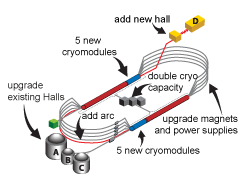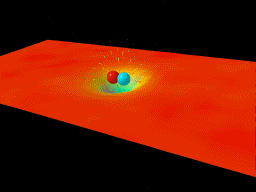|
|
|
|
|
2005 JLab News Release
|
||||||
The Exciting Science of 12 GeVJuly 29, 2005To look into the heart of matter, nuclear physicists need powerful microscopes. These microscopes are called particle accelerators, and Jefferson Lab's particle accelerator, CEBAF, probes the nucleus of the atom by sending a stream of electrons crashing into it. Giant detectors help physicists paint a picture of what the nucleus looks like by allowing physicists to see what happens as a result of the collisions. Currently, CEBAF produces a beam of electrons with up to six billion electron-volts (6 GeV) of energy. Physicists can choose how many electrons they want to send into a target nucleus, what energy they want the electrons to have, how often they want a bunch of electrons to hit the target, and the spin of the electrons when they hit the target. Changing these parameters gives physicists complementary pictures of nuclei.  Upgrading the accelerator to 12 GeV will be a relatively straightforward process. The accelerator will receive additional accelerating cryomodules in the linacs. Stronger magnets will be installed in the nine recirculation arc beam lines to handle a higher-energy electron beam, and a beam line will be added to allow electrons to make an extra pass through one linac before being delivered to a new experimental hall, Hall D. Now, the community of nuclear physicists wants to upgrade CEBAF by doubling the electron's energy. This will allow physicists to get clearer pictures of the finer details of nuclear structure. This project, called the 12 GeV Upgrade, will offer a unique opportunity for nuclear physicists to expand our knowledge of the building blocks of everyday matter. In particular, it will allow groundbreaking research in the following five major areas. 1. Researchers will now be able to look into the structure of atomic nuclei, exploring how the valence quark structure is modified in a dense nuclear medium. These studies will give the world a far deeper and more fundamental understanding of the structure of atomic nuclei, with far-reaching implications for all of nuclear physics and nuclear astrophysics. While the nucleus is built of protons and neutrons, protons and neutrons are made of quarks and gluons. The three permanent quarks in each proton and neutron, called valence quarks, swap gluons. This swapping of gluons glues quarks together into protons and neutrons and glues protons and neutrons into nuclei. Nuclei are far from being a static, uninteresting collection of particles; they're both dynamic and complex. For instance, if you take a proton out of the nucleus, it behaves far differently than it did when inside. What's more, a proton in a nucleus with just a few other protons and neutrons behaves differently than one in a nucleus with many. The 12 GeV Upgrade will allow physicists to find out just how protons are changed inside nuclei. To grasp this, physicists need a better understanding of how quarks build nuclei. They have theories that allow them to describe how quarks and gluons make nucleons and how nucleons make nuclei. But inside nuclei, quarks in one nucleon are interacting with quarks in other nucleons. In essence, the nucleus can be seen as just a collection of quarks and gluons. In this simple view of a nucleus, quarks (red, blue and green) inside three nucleons are interacting by exchanging particles. Larger version. Physicists hope one day to be able to describe how these interacting quarks build nuclei from the bottom up. The 12 GeV Upgrade will make a vital contribution to this program by providing a unique potential for discovery. Allowing scientists a peek into the inner workings of the very building blocks of matter will help them make discoveries about ordinary matter and the matter found in the hearts of stars, like our sun. 2. A second area of research that the upgrade will make possible deals with the Generalized Parton Distributions (GPDs), which will allow researchers, for the first time, to engage in nuclear tomography, discovering the true three-dimensional structure of the nucleon. Since protons and neutrons are the building blocks of the nucleus, physicists often refer to them as nucleons. Currently, our pictures of these particles consist of form factors - equations that describe the shape of nucleons. There are also parton distribution functions, which provide a one-dimensional snapshot of where quarks are in the nucleon. Painstaking probes of nucleons helped physicists develop these descriptions, but they're far from being complete, providing only glimpses at slices of the nucleon's shape. What physicists would like to have is the ability to integrate these slices, in much the same way that a CAT scan machine takes many different x-ray picture slices of the body and integrates them into a 3-D picture. GPDs will allow that. They are experimentally measurable quantities that physicists can use to map out the location and momentum of partons -- the quarks and gluons -- inside a nucleon. For physicists to use GPDs to their full potential, however, high-quality data, such as that made available by the 12 GeV Upgrade, is needed. 3. The combination of luminosity, duty factor and kinematic reach of the 12 GeV machine will far surpass anything available up to this point, allowing the nuclear physics community a previously impossible view of the spin and flavor dependence of the valence parton distributions - the heart of the proton, where its quantum numbers are determined. As building blocks of the proton, valence quarks provide a major contribution to the proton's physical properties, such as its mass, size, spin, and electric and magnetic fields. These properties, and others, are represented by the proton's quantum numbers. Physicists have shown that the 12 GeV Upgrade will yield a clear view of the proton and its quarks, as well as a snapshot of how the proton's building blocks influence its structure. The 12 GeV Upgrade will provide a nearly continuous (high duty factor) beam of higher-energy electrons (luminosity) that will allow physicists to peer deeper (kinematic reach) into the nucleon. These qualities will allow physicists an unprecedented snapshot of valence quarks and their associated gluons in the proton. 4. Through search for exotic mesons, which contain gluons as an unavoidable part of their structure, researchers will explore the fascinating and complex vacuum structure of Quantum Chromodynamics (QCD) and the nature of confinement.  This animation shows what happens when you try to separate a quark-antiquark pair. As the separation between the quarks changes, the "flux tube" of gluons gets longer, but the diameter remains approximately constant. Nuclear physicists will also be looking at other forms of matter. For instance, mesons, which usually contain just two quarks and their associated gluons compare to the proton's three, can be studied as well. Mesons are already all around us; they're created by cosmic rays as they strike Earth's atmosphere, for instance. It's hoped that a special kind of meson, an exotic meson, will be created in an upgraded CEBAF. These exotic mesons are produced by exciting the gluons that bind quarks together via the strong force. The strong force is manifested by quarks as they swap gluons. It is so strong, in fact, that you'll never find a single quark alone, a property of quarks called confinement. The strong force is described by QCD. According to QCD, the strong force permeates the vacuum, the so-called empty space, at the level of subatomic particles. The force and its gluons become more concentrated near quarks, providing extra background energy for quark interactions. Producing exotic mesons will allow physicists to test QCD's description of the strong force. Though predicted by QCD, many of these exotic mesons have never been seen before, and identifying them and their properties will provide information on the strong force, how it confines quarks, and how it contributes to the structure of everyday matter. 5. Lastly, through extremely high precision studies of parity violation, developed in order to study the role of hidden flavors in the nucleon, researchers using the upgraded CEBAF can explore physics beyond the Standard Model, on an energy scale that cannot be carried out even with the proposed International Linear Collider. The Standard Model describes fundamental particles, such as quarks, gluons and electrons, and their interactions. So far, tests of this model have shown that it's accurate. However, the upgrade will provide new opportunities for probing the model's limits. Discovering if and where the Standard Model fails will allow physicists to develop ever more accurate and inclusive theories of matter, providing insights into the fundamental particles that comprise the world around us. Thomas Jefferson National Accelerator Facility’s (Jefferson Lab’s) basic mission is to provide forefront scientific facilities, opportunities and leadership essential for discovering the fundamental structure of nuclear matter; to partner in industry to apply its advanced technology; and to serve the nation and its communities through education and public outreach. Jefferson Lab, located at 12000 Jefferson Avenue, is a Department of Energy Office of Science research facility managed by the Southeastern Universities Research Association. content by Public Affairs maintained by webmaster@jlab.org updated July 29, 2005 |